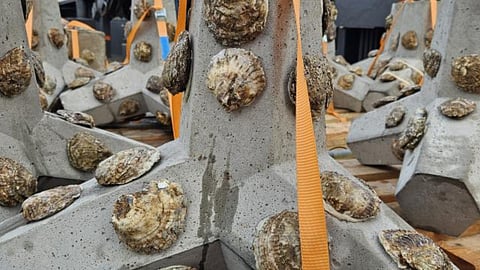Van Oord installs oyster structures at Borssele wind farms in North Sea
Ørsted and Van Oord, via the Ocean Health initiative, have installed droppable oyster structures at the Ørsted-operated Borssele 1 and 2 wind farms in the Dutch sector of the North Sea.
The droppable oyster structures are easily portable reef structures that have adult oysters attached to them. These oysters reproduce by producing larvae, which will then colonise and ultimately form oyster reefs in the wind farm.
Van Oord said the new installation method is an easy and affordable way to introduce oysters on a large scale. Installation of these oyster structures is part of a broader project of restoring the oyster population in the North Sea.
The easily portable oyster structures can be installed by manually placing them on the seabed from the deck of a small vessel. This means that transport and installation can be incorporated into regular maintenance activities carried out at offshore wind farms.
An underwater camera will be used to monitor the structures and the oysters over time with a view to assessing the method’s effectiveness and its impact on the local ecosystem.
Public authorities and conservation organisations have identified the European flat oyster as a key species in efforts to restore and improve the North Sea ecosystem. Offshore wind farms provide hard substrate and undisturbed seabed, making them highly suitable locations for restoring the flat oyster population in the North Sea.
The adult oysters being introduced on the structures function as a source of larvae, which will then colonise the rock present at the site and will eventually grow into oyster reefs. Van Oord said this method promises to be a vast improvement in terms of ease of installation, cost-effectiveness and scalability.


